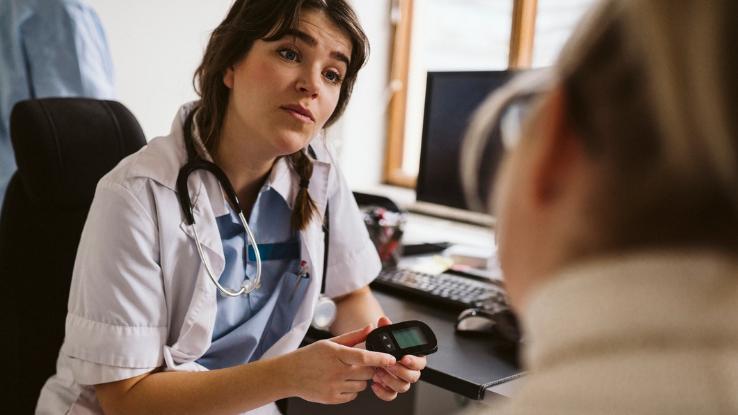Diabetes 101: Your Complete Guide

Diabetes is a health condition that develops when your body can’t process sugar normally. It leads to higher-than-normal blood glucose (sugar) levels. Without treatment, high blood sugar from diabetes can damage your organs and other body systems.
According to the American Diabetes Association, over 34 million Americans have diabetes — that’s more than 1 in 10 Americans. And at least 7 million of those people don’t know they have it. That’s why it’s so important to learn about recognizing, preventing and treating diabetes.
When you eat, your stomach and small intestine absorb sugar from food and release it into your bloodstream. Then your body releases a hormone called insulin to make your cells take the sugar from your blood and use it for energy. When this process works the way it’s supposed to, your blood sugar stays in a healthy range.
But when you have diabetes, this process doesn’t work correctly. In Type 1 diabetes, your pancreas produces little or no insulin. In Type 2 diabetes, your cells have trouble responding to insulin and absorbing sugar from your blood. Type 1 usually starts in childhood or teen years, while Type 2 usually starts in adulthood.
The good news is that you can take steps to prevent diabetes. And if you’ve already been diagnosed, you can take steps to manage your blood sugar. Getting the treatment you need can help prevent the most serious effects of diabetes.
What Are the Types of Diabetes?
Type 2 diabetes is much more common than Type 1 — more than 9 out of 10 people with diabetes have Type 2. Learn about the types and how they’re different.
Type 1 Diabetes
In Type 1 diabetes, your immune system destroys the cells in your pancreas that make insulin. Eventually, your body loses the ability to produce any insulin at all. Without insulin, your body can’t use the sugar it absorbs from the food you eat. Instead, the sugar stays in your blood.
Type 1 diabetes is a lifelong condition that’s often diagnosed in children and teens. That’s why it’s sometimes called “juvenile diabetes.” However, people can develop Type 1 at any age. Symptoms often come on rapidly over a period of weeks or months. Common symptoms include weight loss, weakness, thirst and frequent urination.
There’s no cure for Type 1 diabetes, but you can manage it with insulin therapy and an eating plan.
Type 2 Diabetes
Where Type 1 involves a problem with your pancreas making insulin, Type 2 usually involves changes in your body’s cells and how they respond to insulin.
With Type 2 diabetes, your fat, liver, muscle and other cells begin to ignore insulin signals, even when there’s plenty of insulin in your bloodstream. Over time, your pancreas produces more and more insulin, and your body’s cells respond less and less. This process is called insulin resistance. As a result, sugar builds up in your bloodstream.
Unlike the quick start of Type 1 diabetes, Type 2 diabetes happens gradually over a period of months or years. Symptoms are usually less noticeable, and people with Type 2 diabetes may not know they have it.
You can manage Type 2 diabetes with a combination of medicines and lifestyle changes. These changes include getting to a healthy weight, eating healthy and getting more exercise. Unlike Type 1 diabetes, Type 2 diabetes can go into remission with effective management. Some people with Type 2 can manage their blood sugar with lifestyle changes alone, while others need medicines as well.
Prediabetes
Prediabetes develops when your blood sugar is higher than normal levels, but isn’t high enough to be considered Type 2 diabetes yet. More than 1 in 3 Americans has prediabetes — but because it has no symptoms, most people don’t know they have it. If you’re diagnosed with prediabetes, you can make lifestyle changes to prevent it from turning into Type 2 diabetes.
Gestational Diabetes
Gestational diabetes happens during pregnancy. It can be hard to notice the symptoms, so doctors recommend that all pregnant people get screened for gestational diabetes at 24 weeks.
What Are the Symptoms of Diabetes?

Depending on the type of diabetes you have and how high your blood sugar is, you might not notice any symptoms at first. Early symptoms of diabetes include:
- Frequent urination (having to pee more often than usual)
- Feeling very thirsty and drinking more fluids than usual
As your body has more and more trouble processing sugar from the foods you eat, you may notice:
- Irritability
- Fatigue and weakness
- Unexpected weight loss
- Feelings of hunger
- Nausea
Complications from diabetes can lead to more severe symptoms. These may also happen if you have diabetes that’s undiagnosed, or if you don’t get treatment for your diabetes. These symptoms include:
- Blurred vision
- Skin infections
- Slow healing of wounds
- Numbness or tingling of the hands or feet
- Sexual problems like erectile dysfunction
Warning signs of diabetes can be subtle. Talk with your doctor if you notice any of these signs:
- Waking up during the night feeling very thirsty
- Waking up to pee more than once per night
- Falling asleep during the day
- Not noticing minor injuries on your hands or feet
- Not being able to feel hot or cold temperatures with your fingers
- Color changes in your feet
- Having trouble with sexual arousal
Remember, there are effective treatments for diabetes. That’s why it’s important to get help right away if you notice symptoms.
What Causes Diabetes? Am I at Risk?
Causes and Risk for Type 1
Experts believe Type 1 diabetes is primarily genetic, but there’s no single gene that can tell you your risk for diabetes. Researchers have found several genes that may increase your risk of getting Type 1 diabetes.
Environmental factors probably also affect your risk for Type 1 diabetes — but researchers don’t yet understand exactly what role these play. For example, Type 1 diabetes is more common in certain parts of the world and in urban areas. There may also be a link between Type 1 diabetes and contact with certain types of bacteria and viruses in early childhood.
Causes and Risk for Type 2
Like Type 1 diabetes, there’s also not one exact cause of Type 2 diabetes. However, there are several risk factors that can increase your risk for Type 2 diabetes, including:
- Family history — Genes play a role, so you’re more likely get Type 2 diabetes if you have a parent or sibling with the condition.
- Weight — Obesity is the strongest risk factor for Type 2 diabetes, especially if you have extra weight around your waistline. Experts aren’t sure exactly how weight affects diabetes risk, but they think fat cells may play a role in insulin resistance.
- Physical activity level — Lack of exercise can raise your risk for Type 2 diabetes.
- Smoking — People who smoke are more likely to get Type 2 diabetes. So if you smoke, make a plan to quit.
- Diet — People whose diets are high in dairy products, carbohydrates and red meat have a higher risk for Type 2 diabetes than people whose eat mainly fruits, vegetables, white meat and whole grains.
- Other health conditions — High blood pressure, high cholesterol and heart disease can raise your risk for diabetes.
Your risk also goes up as you get older.
How Can I Prevent Diabetes?
There’s no way to prevent Type 1 diabetes — but you can take steps to prevent Type 2 diabetes by maintaining a healthy lifestyle. Follow these steps:
- Stay at a healthy weight. If you’re overweight, talk with your doctor about healthy ways to manage your weight.
- Get more physical activity. Aim for at least 2 and a half hours of activity a week.
- Eat a healthy, balanced diet with lots of fruits, veggies and whole grains.
- If you smoke, make a plan to quit.
If you already have diabetes, you can prevent complications by controlling your blood sugar. This means following all your doctor’s recommendations, checking your blood sugar regularly, planning your meals and taking your insulin or other diabetes medicines at the right times.
How Do Doctors Diagnose Diabetes?
Doctors diagnose diabetes with blood tests. You’ll usually need to fast before the test, meaning you can’t eat or drink anything but water for a set number of hours beforehand. When you’ve been fasting, your blood sugar should be between 70 mg/dl and 99 mg/dl (milligrams of sugar per deciliter of blood).

Your doctor may also recommend a glucose tolerance test. This measures your blood glucose (sugar) levels before and after you eat or drink a certain amount of sugar. That way, the doctor can see how your body processes the sugar.
To get a more long-term picture of your blood sugar over time, your doctor may do a hemoglobin A1C test. The results of this test show your average blood sugar levels over several months. A reading of 5.7% or less is considered normal for someone without diabetes.
Because Type 2 diabetes is common, doctors often offer screening tests to people who are at risk of developing diabetes, including people who are overweight and between ages 35 and 70. As part of the screening process, your doctor may ask you about any diabetes symptoms you have, your eating and exercise habits, and any family history of diabetes.
You may also need a physical exam, which includes checking your weight and blood pressure. If you’re already experiencing diabetes symptoms, your doctor may check for problems with your eyesight and sensation in your feet. You may also need a urine test to check for signs of diabetes or kidney problems.
What Are the Treatments for Diabetes?
If you’re diagnosed with diabetes, your doctor will work with you to make a personalized treatment plan. There are several common treatments that are likely to play a role in the ways you manage life with diabetes.
Insulin Therapy
The main treatment for people with Type 1 diabetes is insulin. Some people with Type 2 diabetes also need insulin to manage their blood sugar. You can take insulin using a pen-like device that you insert directly into your skin. Some people use wearable insulin pumps, which can automatically give you the correct amount of insulin based on your blood sugar readings.
There are several different types of insulin:
- Long-acting insulins deliver a constant dose of insulin for an extended period of time (typically 20 to 24 hours). People usually take doses of these once or twice a day so their bodies always have enough insulin available.
- Intermediate-acting insulins work within 2 to 4 hours. They peak (hit their maximum effect) at between 4 and 12 hours and continue working for up to 18 hours.
- Short-acting insulins work within 30 minutes. They peak within 2 or 3 hours and continue working for between 12 and 18 hours.
- Rapid-acting insulins work within a few minutes. They peak within an hour and continue to work for between 2 and 4 hours. People often take them at mealtimes and measure the dose according to the amount of sugar in the meal.
It’s important to talk with your doctor regularly about your insulin treatment plan. Your doctor or a diabetes educator can teach you how to make sure you’re getting the right amount and type of insulin at the right time.
Other Diabetes Medicines
Medicines for Type 2 diabetes can help your body respond to insulin more effectively. Common diabetes medicines include the following:
- Biguanides, such as Metformin, help reduce the amount of glucose your liver produces. They also help your body better respond to insulin and absorb the sugars you eat more effectively.
- Dipeptidyl peptidase-4 (DPP-4) inhibitors, such as Alogliptin and Saxagliptin, help your pancreas produce more insulin.
- Sulphonylureas, such as Gliclazide, stimulate your pancreas to produce more insulin.
- Thiazolidinediones, such as Pioglitazone, reduce insulin resistance in fat cells.
- Glucagon-like peptide-1 (GLP-1) receptor agonists, such as Exenatide and Liraglutide, improve insulin secretion from your pancreas.
- Sodium-glucose transporter (SGLT) 2 inhibitors help your kidneys get rid of excess glucose.
People with Type 2 diabetes sometimes also need insulin therapy.
Type 2 diabetes can also increase your risk of developing other health conditions, like high cholesterol or high blood pressure. So your doctor may also recommend medicines to lower your risk of developing these conditions.
Changing Your Diet
What you eat plays a large role in both the prevention and control of diabetes. If you have diabetes, try to cut down on saturated fats. Choose lean meats like chicken and turkey instead of red meat. And try eating vegetable oils, nuts and seeds instead of fatty meats and dairy products.
Your doctor may also recommend a low-sugar diet and suggest swapping simple and refined carbohydrates (like candy, pastries and white bread) for complex carbohydrates such as whole grains and legumes (like beans and lentils).
Monitoring Your Blood Sugar
If you’ve been diagnosed with diabetes, it’s important to see your doctor for regular checkups. Your doctor can monitor your A1C level to see how well your treatment plan is working. The higher your A1C level is, the greater your risk is of developing complications of diabetes.
You’ll also need to monitor your blood sugar yourself throughout the day, especially before and after meals. You’ll use a glucose monitor device to do this. This device checks your blood sugar using a tiny drop of blood from a finger prick. Some people use continuous glucose monitors to constantly monitor their blood sugar levels.
What Complications Can Diabetes Cause?
Without treatment and lifestyle changes to manage your blood sugar, diabetes can lead to serious complications.
Hypoglycemia (Low Blood Sugar)
Sometimes, treatments for diabetes can make your blood sugar too low. Low blood sugar causes symptoms like weakness, trembling, palpitations, abdominal pain, nausea and vomiting. In some cases, it can cause loss of consciousness, seizures and even death. If you’re taking insulin or other medicines that lower your blood sugar levels, it’s important to be aware of these symptoms and to check your blood sugar regularly.
Diabetic Eye Disease
Diabetic retinopathy and other diabetic eye diseases are the most common diabetes complication. High blood sugar levels can damage the tiny blood vessels in your eyes.
You may not notice any symptoms in the early stages, but untreated diabetic eye disease can lead to vision loss and even blindness. If you have diabetes, it’s important to see an eye doctor for regular eye exams. And if you notice changes in your vision, tell your doctor right away.
Kidney Damage
Diabetes can damage the blood vessels inside your kidneys, causing kidney disease. Kidney disease often has no symptoms until later stages. So your doctor may recommend screening tests to find signs of kidney problems early. Without treatment, kidney disease can lead to kidney failure. High blood pressure can also cause kidney damage, so it’s important to keep your blood pressure within the normal range.
Nerve Damage
Diabetic nerve damage (called neuropathy) can develop if your blood sugar levels remain too high. Nerve damage usually affects your hands and feet first. It may cause symptoms such as tingling or numbness. Diabetes can also damage nerves in the genitals, leading to sexual problems like erectile dysfunction.
Heart Disease
High blood sugar damages your blood vessels, especially the vessels in your heart. This means people with diabetes have a higher risk of developing heart disease and related conditions like angina and heart attacks. If you have heart attack symptoms like chest pain, get help right away.
Infections
Diabetes raises your risk for infections — particularly skin infections. People with uncontrolled diabetes often get fungal infections. These cause an itchy rash in sweaty areas like the groin, under the breasts or in skin folds. You can treat these infections with anti-fungal cream, but it’s important to tell your doctor as soon as you notice symptoms.
Oral Health Problems
People with diabetes are also prone to developing mouth infections and gum disease. It’s essential to brush your teeth twice per day and have regular dental cleanings and checkups.
Foot Complications
The combination of loss of normal sensation due to diabetic neuropathy and poor circulation in the feet means that you might not be able to feel pain signals from small injuries, blisters or ulcers. Keep an eye on your feet, and address any sores or blisters right away.
If you have problems with your feet, you may need to see a diabetes foot specialist, called a diabetic podiatrist. In severe cases of foot infection, it may be necessary to amputate the affected foot.
Diabetic Ketoacidosis
People with Type 1 diabetes develop a condition called diabetic ketoacidosis (DKA). DKA happens when your body has too little insulin to let sugar enter your cells. Since it can’t use sugar for energy, your body gets energy from other places, such as your fat and muscle tissue. This creates byproducts called ketones, which can change the chemical balance of your blood and make you ill.
Symptoms of DKA (in addition to other diabetes symptoms) include:
- Breathlessness
- Extreme fatigue
- Abdominal pain
- Nausea and vomiting
- Confusion
- Loss of consciousness
- Seizures
Your Next Steps for Living With Diabetes
Managing diabetes takes time and effort — but the good news is that treatments and lifestyle changes can help you manage your blood sugar and avoid diabetes complications. You can work with your doctor to develop a healthy eating and activity plan. Your doctor may also prescribe medicines to manage your symptoms.

It’s important to remember that diabetes is very treatable, and you can live a long and healthy life with diabetes by following your treatment plan. Your doctor can also help you find resources to help you live with diabetes — like referring you to a diabetes educator or support groups for people with diabetes.
And the changes you make to manage your diabetes can also reduce your risk of other conditions, like heart disease and cancer. So start taking steps today to manage your diabetes and protect your overall health.
Resource Links
- “Type 2 Diabetes” via MedlinePlus
- “Diabetes” via National Health Service (UK)
- “Overview of Diabetes” via BMJ Best Practice
- “Diabetes” via World Health Organization
- “Physical Activity Guidelines for Americans, 2nd edition” via U.S. Department of Health and Human Services
- “Division of Diabetes Translation” via Centers for Disease Control and Prevention
- “Statistics About Diabetes” via American Diabetes Association
- “Type 1 Diabetes” via Mayo Clinic
- “Prediabetes” via Mayo Clinic





